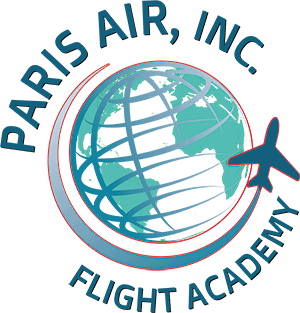When you’re behind the controls of an aircraft, the world looks completely different. Roads and buildings shrink, landscapes stretch endlessly, and Florida reveals a side that most people will never see. For Paris Air students, flying isn’t just about mastering skills in the cockpit — it’s also about experiencing some of the best views from the sky in Florida, and learning to recognize VFR landmarks that make training both practical and memorable.
Why Flying Over Florida Is Ideal for Pilots
With more than 300 days of sunshine each year, a mix of coastline and wetlands, and one of the most vibrant aviation cultures in the world, Florida is the perfect place to train. Smooth weather conditions and diverse landscapes mean that every flight has something new to offer. And while tourists on the ground may flock to beaches and theme parks, pilots know that the real treasures are found in the skies.
Best VFR Landmarks in Florida: Hidden Gems From the Sky
Indian River Lagoon & Barrier Islands
Stretching along Florida’s east coast, the Indian River Lagoon is a vast network of mangroves, estuaries, and winding waterways. From the air, it’s easy to see why this is one of the most biologically diverse estuaries in North America. “When students first see the Indian River from the cockpit, it becomes more than just a map detail — it’s a living landmark that helps them orient themselves,” says one Paris Air instructor.
NASA’s Kennedy Space Center
Flying near the Space Coast offers a truly unique perspective. Students can often spot the enormous Vehicle Assembly Building, the launch pads, and the stretch of coastline that has been the starting point for decades of space exploration.
Everglades National Park
From above, the Everglades take on a completely different dimension — endless wetlands dotted with rivers and sawgrass plains that stretch to the horizon. This makes for both breathtaking views and an excellent training exercise in identifying large, natural landmarks.
The Florida Keys
Seen from the sky, the Keys are a chain of emerald islands surrounded by turquoise waters, with the famous Overseas Highway weaving them together. “There’s nothing like pointing out the Keys on a student’s first cross-country flight — it feels like flying into a postcard,” an instructor explains.
Historic St. Augustine
America’s oldest city stands out from the air with its iconic Castillo de San Marcos fort, coastal waterways, and historic harbor. The distinct layout provides an excellent reference point for practicing navigation skills.
Central Florida’s Lakes & Springs
Central Florida’s landscape is dotted with hundreds of freshwater lakes and natural springs. From altitude, their striking blue-green hues create a patchwork of landmarks that make excellent VFR reference points.
Lake Okeechobee
This massive inland lake is visible from miles away, and its near-perfect circular shape makes it one of the most recognizable VFR landmarks in Florida. Its sheer size makes it an easy checkpoint for navigation across central and southern Florida.
Cape Canaveral & Cocoa Beach
The combination of pristine coastline, barrier islands, and the unmistakable Cape Canaveral airfield creates one of the best views from the sky in Florida. Students quickly learn how to use the Cape and surrounding waterways as clear visual references during training flights.
✈️ Student Tips: Using Landmarks in VFR Navigation
- Plan ahead with sectional charts. Before each flight, identify potential landmarks such as rivers, highways, or large lakes that you’ll use along your route.
- Cross-check multiple features. Don’t rely on just one landmark. Look for at least two confirming features (e.g., a lake and a highway intersection) to verify your position.
- Use landmarks as progress markers. Break your route into smaller legs by selecting key points. This helps maintain orientation and improves accuracy during cross-country flights.
The Value of VFR Navigation in Pilot Training
Flying over Florida offers much more than beautiful views — it plays an important role in VFR (Visual Flight Rules) training. Students learn to identify and rely on natural and manmade landmarks, from rivers and highways to coastlines and cities. These VFR landmarks in Florida are critical for maintaining situational awareness, building confidence in navigation, and preparing students for cross-country flights. With its unique blend of coastlines, wetlands, and urban development, Florida is one of the best training grounds in the country for mastering VFR skills.
Flying Over Florida From Vero Beach Regional Airport
Training out of Vero Beach Regional Airport adds another layer of value for Paris Air students. Located in Class D airspace, the airport provides direct exposure to professional air traffic communications while still being approachable for beginners. Students practice standard departure and arrival procedures, communicate with a busy tower, and become familiar with nearby airways that connect to coastal and inland practice areas.
The location also offers quick access to both coastal flights over the Indian River Lagoon and inland routes toward Lake Okeechobee or Central Florida’s lakes. This makes Vero Beach an ideal hub for building confidence in cross-country navigation while experiencing some of the best views from the sky in Florida.
Ready to Experience Flying Over Florida?
Flying over Florida is more than logging hours in a logbook. It’s about discovering hidden gems from the sky, mastering the art of VFR navigation, and experiencing firsthand some of the best views from the sky in Florida. At Paris Air, every flight is both a lesson and an adventure.
Whether you’re circling the Indian River Lagoon, flying past the Space Coast, or crossing over Lake Okeechobee, the views you’ll experience while training at Paris Air are unforgettable. Ready to take the first step? Contact us today to schedule your discovery flight and see Florida the way only pilots can.

